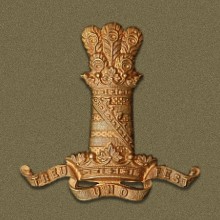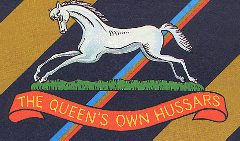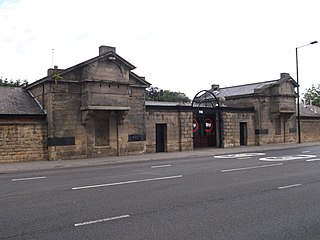
The 11th Hussars was a cavalry regiment of the British Army established in 1715. It saw service for three centuries including the First World War and Second World War but then amalgamated with the 10th Royal Hussars to form the Royal Hussars in 1969.

The Queen's Own Hussars, normally referred to by the abbreviation QOH, was a cavalry regiment of the British Army, formed from the amalgamation of the 3rd The King's Own Hussars and the 7th Queen's Own Hussars at Candahar Barracks, Tidworth in 1958. The regiment served in Aden and Northern Ireland and as part of the British Army of the Rhine. The regiment was amalgamated with the Queen's Royal Irish Hussars to form the Queen's Royal Hussars on 1 September 1993.

The Queen's Royal Irish Hussars, abbreviated as QRIH, was a cavalry regiment of the British Army formed from the amalgamation of the 4th Queen's Own Hussars and the 8th King's Royal Irish Hussars in 1958. The regiment saw active service against insurgents in Aden; during the Indonesia–Malaysia confrontation and during the Gulf War. The regiment was amalgamated with the Queen's Own Hussars to form the Queen's Royal Hussars on 1 September 1993.

The Queen's Royal Hussars (QRH) is the senior United Kingdom armoured regiment. It was formed on 1 September 1993 from the amalgamation of the Queen's Own Hussars and the Queen's Royal Irish Hussars. The regiment and its antecedents have been awarded 172 Battle Honours and eight Victoria Crosses. The regiment is currently based in Sennelager, Germany, where it is the armoured regiment for 20th Armoured Brigade, part of British Forces Germany.

The Light Dragoons (LD) is a cavalry regiment in the British Army. The regiment is a light cavalry regiment with a history in the reconnaissance role which dates back to the early eighteenth century. It is currently based in Catterick Garrison North Yorkshire.

The King's Royal Hussars (KRH) is a cavalry regiment of the British Army. It is part of the Royal Armoured Corps. The regiment was formed in 1992 and is based at Tidworth. It serves as the armoured regiment of the 12th Armoured Infantry Brigade. Under Army 2020 Refine, it will exchange its Challenger 2 tanks for Ajax vehicles.

The 15th/19th The King's Royal Hussars was a cavalry regiment of the British Army. The regiment was formed by the amalgamation of the 15th The King's Hussars and the 19th Royal Hussars in 1922 and, after service in the Second World War, it was amalgamated with the 13th/18th Royal Hussars to form the Light Dragoons in 1992.

The 13th/18th Royal Hussars was a cavalry regiment of the British Army. It was formed by the amalgamation of the 13th Hussars and the 18th Royal Hussars in 1922 and, after service in the Second World War, it amalgamated with the 15th/19th The King's Royal Hussars to form the Light Dragoons in 1992.

The 10th Royal Hussars was a cavalry regiment of the British Army raised in 1715. It saw service for three centuries including the First World War and Second World War but then amalgamated with the 11th Hussars to form the Royal Hussars in October 1969.

The 14th/20th King's Hussars was a cavalry regiment of the British Army. It was created by the amalgamation of the 14th King's Hussars and the 20th Hussars in 1922 and, after service in the Second World War, it amalgamated with the Royal Hussars to become the King's Royal Hussars in 1992.

The 19th Royal Hussars was a cavalry regiment of the British Army, created in 1858. After serving in the First World War, it was amalgamated with the 15th The King's Hussars to form the 15th/19th The King's Royal Hussars in 1922.

The 18th Royal Hussars was a cavalry regiment of the British Army, first formed in 1759. It saw service for two centuries, including the First World War before being amalgamated with the 13th Hussars to form the 13th/18th Royal Hussars in 1922.

The 4th Queen's Own Hussars was a cavalry regiment in the British Army, first raised in 1685. It saw service for three centuries, including the First World War and the Second World War. It amalgamated with the 8th King's Royal Irish Hussars, to form the Queen's Royal Irish Hussars in 1958.

The 8th King's Royal Irish Hussars was a cavalry regiment in the British Army, first raised in 1693. It saw service for three centuries including the First and Second World Wars. The regiment survived the immediate post-war reduction in forces, and went on to distinguish itself in the battles of the Korean War, but was recommended for amalgamation in the 1957 Defence White Paper prepared by Duncan Sandys. The regiment was amalgamated with the 4th Queen's Own Hussars, to form the Queen's Royal Irish Hussars in 1958.

The 15th The King's Hussars was a cavalry regiment in the British Army. First raised in 1759, it saw service over two centuries, including the First World War, before being amalgamated with the 19th Royal Hussars into the 15th/19th The King's Royal Hussars in 1922.

The 7th Queen's Own Hussars was a cavalry regiment in the British Army, first formed in 1689. It saw service for three centuries, including the First World War and the Second World War. The regiment survived the immediate post-war reduction in forces, but following the 1957 Defence White Paper, it was amalgamated with the 3rd The King's Own Hussars, forming the Queen's Own Hussars in 1958.

The Queen's Own Oxfordshire Hussars was the designated name of a Yeomanry regiment of the British Army formed in 1794. It saw service in the Second Boer War with 40 and 59 Companies of the Imperial Yeomanry and also served in Belgium and France during the Great War. In 1922, the regiment became part of the Royal Artillery. The lineage is maintained by 142 Vehicle Squadron Royal Logistic Corps.
In countries whose armies are organised on a regimental basis, such as the army of the United Kingdom, a regimental museum is a military museum dedicated to the history of a specific army regiment.

Fenham Barracks is a military installation in Barrack Road, Newcastle upon Tyne.





















